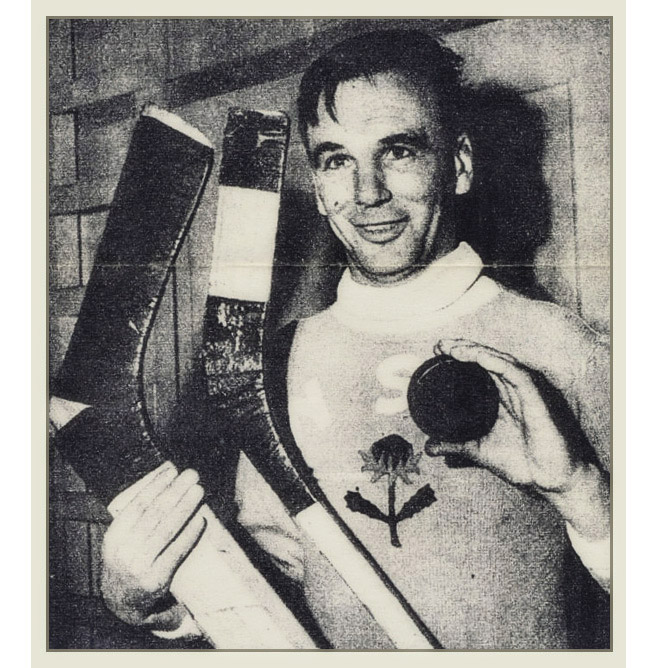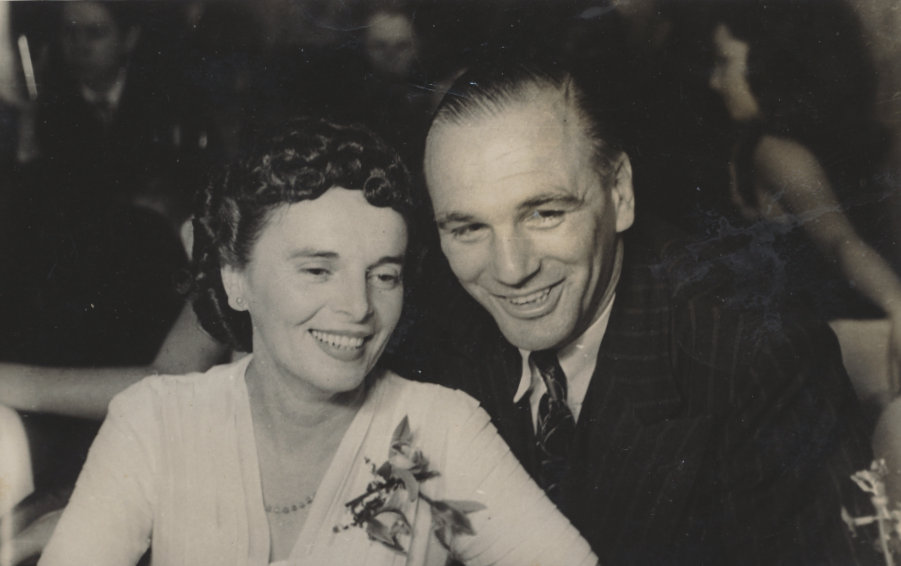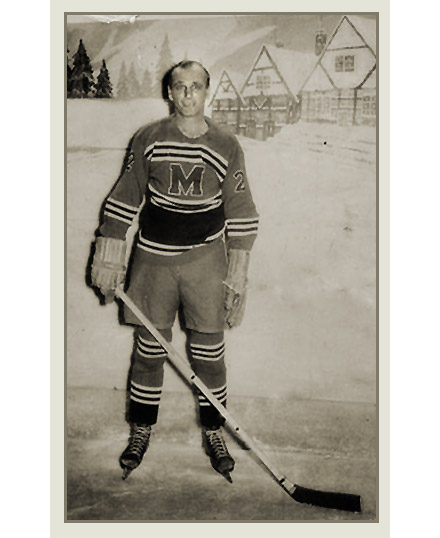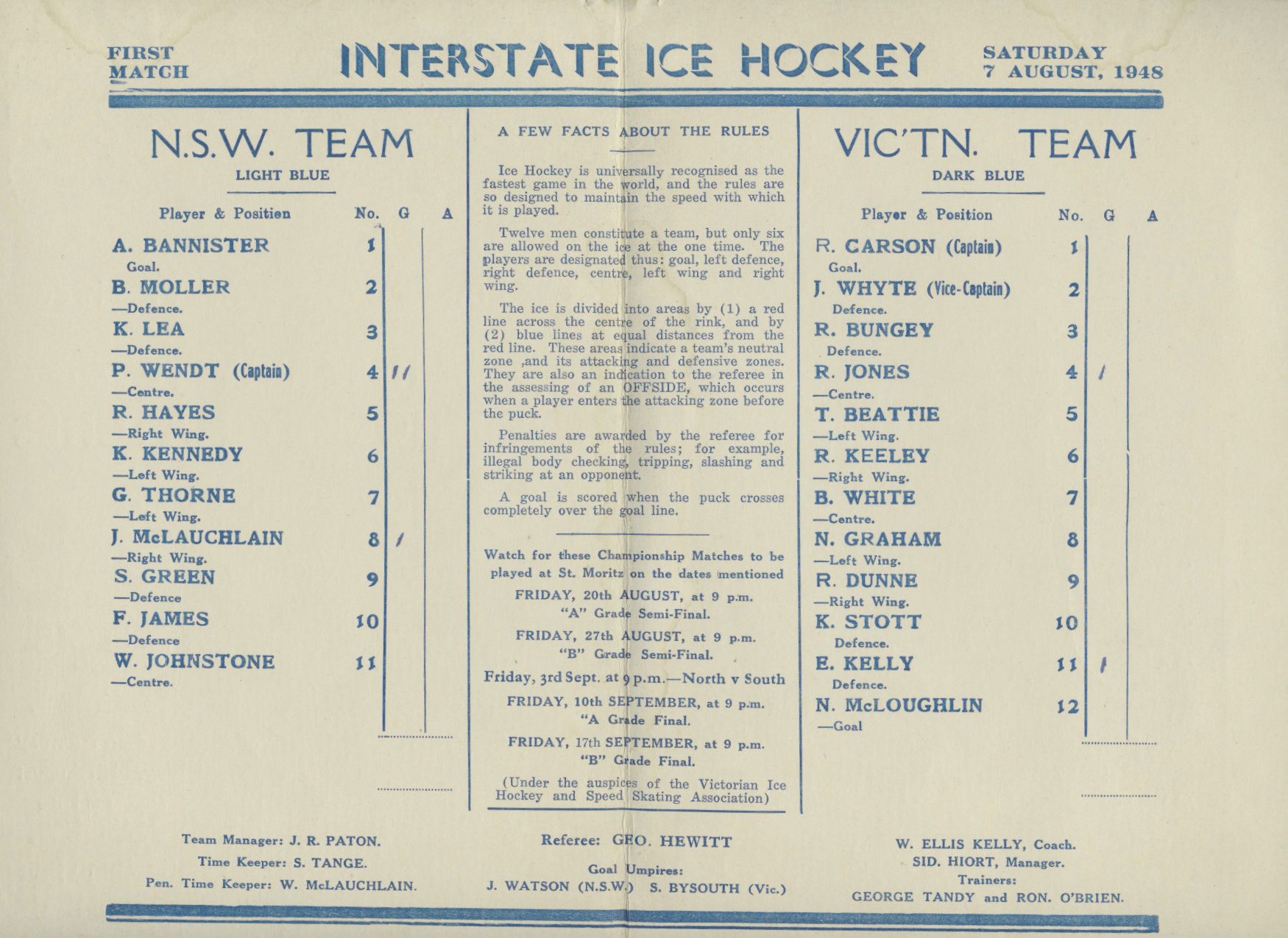Legends
home
From a desert, from the driest continent, from this land at the opposite end of the globe ...
... as remote as could be in the hockey world ...
... came one of the world’s oldest winter sports trophies.
A cool tradition, a dream of champions, and a story we owe it to our children to tell.
Legends of Australian Ice.
[ ICE HOCKEY ] Lefty
Percy Frederick Otto Wendt (1912 - 1995)
![]() Wendt does not shirk the rough and tumble when it comes to a point, but he prefers to dazzle the opposition with science in a remote and unconnected sort of way, leaving in his wake a puzzled lot of players who feel so completely thwarted that they would like to whack him hard with their sticks. Wendt has that summation of skills that marks the ice hockey genius. He can handle the puck with his stick as effectively as most fans can handle their knives and forks, and he swerves like nothing so much as an errant possum, in and out, round and about, and always with some fell purpose hidden way back in his brain-box, which when revealed makes you gasp at his subtlety. Sports Journalist "Left Defense", Referee, Sydney NSW, May 27th 1937.
Wendt does not shirk the rough and tumble when it comes to a point, but he prefers to dazzle the opposition with science in a remote and unconnected sort of way, leaving in his wake a puzzled lot of players who feel so completely thwarted that they would like to whack him hard with their sticks. Wendt has that summation of skills that marks the ice hockey genius. He can handle the puck with his stick as effectively as most fans can handle their knives and forks, and he swerves like nothing so much as an errant possum, in and out, round and about, and always with some fell purpose hidden way back in his brain-box, which when revealed makes you gasp at his subtlety. Sports Journalist "Left Defense", Referee, Sydney NSW, May 27th 1937.
![]() Percy Wendt, who came in for some eulogies in 'The Referee' a fortnight ago, earned them all over again. But he went even further, this wizard of the swerving skates, for his shooting at goal was so good that even the die-hards who have been watching the game for as many years as Wendt has lived, openly averred that his shooting came up level to that of the great Jimmy Kendall, who remains in their minds as the Don Bradman of Australian ice-hockey. Wendt, with a flick of the stick that reminds one forcibly of the famous Indian field hockey players, was able to shoot the puck from any angle or distance. Two of his shots on Thursday, from half-way, went zooming high over the goal, phenomenal examples of strength of wrist and precision of timing. Mr J Kennedy, well-known Ice-hockey official, commented that Wendt is to ice-hockey what a master of the rapier is to fencing. Sports journalist "Left Defense", Referee, Sydney NSW, June 10th 1937. The official J Kennedy" was Jack or "Pop", father of Ken.
Percy Wendt, who came in for some eulogies in 'The Referee' a fortnight ago, earned them all over again. But he went even further, this wizard of the swerving skates, for his shooting at goal was so good that even the die-hards who have been watching the game for as many years as Wendt has lived, openly averred that his shooting came up level to that of the great Jimmy Kendall, who remains in their minds as the Don Bradman of Australian ice-hockey. Wendt, with a flick of the stick that reminds one forcibly of the famous Indian field hockey players, was able to shoot the puck from any angle or distance. Two of his shots on Thursday, from half-way, went zooming high over the goal, phenomenal examples of strength of wrist and precision of timing. Mr J Kennedy, well-known Ice-hockey official, commented that Wendt is to ice-hockey what a master of the rapier is to fencing. Sports journalist "Left Defense", Referee, Sydney NSW, June 10th 1937. The official J Kennedy" was Jack or "Pop", father of Ken.

Percy Wendt in State colours, a favourite with Sydney fans. He was never booed and he appreciated the fact. Image courtesy Sporting Life magazine, 1953 [5]
CHRISTMAS EVE IN MOSCOW is cold with snow but it is not the night the Russians wait for presents from the white bearded man in red robes named Grandfather Frost. That happens two weeks later, which is just as well because there, on this particular Christmas Eve in 1912, Fritz and Julia Wendt were celebrating the birth of their own child. [5] The Russian Futurists were also born in Moscow that month and whether due to the ice and snow, osmosis, or the singularity of interplanetary dust, no-one knows, it just was, that the newborn named Percy inherited the same fascination with dynamism, speed, and the restlessness of urban life.
Nineteen-twelve in pre-Soviet Moscow was a good year, the year the Museum of Fine Arts opened, the Durov Animal Theater was founded, and the Borodinsky Bridge over the Moskva River was rebuilt. The Union Cold Storage Company there was a part of one of the world's largest cold storage operations that began life at the turn of last century as the Union Cold Storage and Ice Company of Liverpool Ltd. Such was the enterprise of the UK-based Vestey Brothers, they soared like skyrockets bursting into the glittering constellation of companies known individually as the Union International Company, the Blue Star Shipping Line, and the Albion Insurance Company.
If you had met their blue-eyed, brown-haired book-keeper with glasses named Fritz back then, you could easily have mistaken him as Russian or South African or Canadian or many nationalities other than English which, of course, he was. Long ago the Wendt family name was German and Danish, and while Fritz was born in London's south-east suburb of Forest Hill, [5] that was also long ago, and he was now counting the beans of multi-national expansions, living a year or two at a time in England, Russia; England, South Africa; England, Canada; the last-mentioned of these places being where he met and married his wife, Julia Roots. [5]

Percy and his wife, Eileen Coady, who was born in Sydney, Australia. [5]
The Roots family was probably the reason the Wendts more or less came to rest there although, for the globe-trotting Fritz, it was really more or less a matter of acquiring another passport. Their daughter was born there. [5] Percy spent the formative development years of his hockey career there, in the village of Parkdale in Toronto, from around the time the Sunnyside Amusement Park and Palais Royale opened nearby. Parkdale back then was one of Toronto's most desirable places to live, situated as it was by the lake, nearby the Canadian National Exhibition, and Sunnyside Beach.
Junior players from all across the province participated in provincial playoffs in Ontario at that time, in the hope of representing Eastern Canada in the Memorial Cup finals, a two-game total-goals tournament against a champion team from Western Canada. The two champions teams were determined through a series of playdowns under the auspices of the Canadian Amateur Hockey Association. Today the Cup is the prize of the Canadian Hockey League (CHL), the governing body for Major Junior Hockey in Canada (formerly Tier One Junior A).
Young Percy celebrated his 16th birthday at sea on MMV Aorangi. He arrived in Australia with his family from Vancouver BC on January 4th 1929 and they lived in the terrace house at No 10 Craigend Street in Darlinghurst. [5] It was immediately east of Sydney's Central Business District, from where Fritz continued to account. Fritz may have left Vestey Brothers although it was quite possible he was still in their employ. They held extensive land holdings at Wave Hill cattle station in Kalkarindji in Australia. A Northern Territory government inquiry held in the 1930s said of Vesteys: "it was obvious that they had been ... quite ruthless in denying their Aboriginal labour proper access to basic human rights". Percy would not have cared for that. Ruthless he was not. He swam at Tamarama Beach, played cricket at Rushcutter's Bay, and golf at Moore Park. He liked sport. A lot.

Left to right: Sid Green, Jim Fox, Percy Wendt and Brian Dewhurst in a practice match in May 1949. Image: Sunday Herald 15 May 1949 p 3S
Pop Kennedy steered the thin-faced, tall and lanky youngster who sauntered into the Glaciarium, directly into Easts' dressing-room. Pop was the father of Ken, the Olympic speed skater and hockey player. It was known Pop was prepared to lie in wait for considerable periods to poach an 18 year-old Canuck fresh off the boat. Wendt was no match for the wiley old coot. He was trapped protesting in an Easts jersey and pads, with a stick thrust in his hand, no less than six seasons out from Easts' last premiership. A few fans laughed when Wendt skated out a short time later in his queer, shuffling style with the Easts reserves. But not Pop. Partnered with Ken Kennedy and Pat Jackson, Wendt made the St George Reserves look ordinary, and so Pop pounced again, from a new place of concealment. Wendt just grinned when told he still had the late game to go against Jimmy Brown's Dragons. "Well, I'm easy" he told Pop, "but I haven't played for two years."

PERCY WENDT (NSW captain) about to shoot to score one of NSW's nine goals against Victoria's four in last night's ice hockey match at the Glaciarium. Victorian goalkeeper Noel McLoughlin, seen defending, was hit in the mouth by the puck, knocking out a couple of teeth. Truth, Sydney, NSW, 29 August 1948 p 18
Jimmy Brown was by then becoming a little legendary in his own lifetime, in local and not-so-local hockey circles. St George's Swedish keeper, Lennart Blomberg, thought Brown could hold his own in any Swedish pro team. Brown had after all caught everyone napping when he broke British speed records, and adding to the mystique was a new style of play he was instilling in St George. This came courtesy of his former London team, the Grosvenor House Canadiens, who the Dragons seemed intent on becoming, right down to their colours. The Canadiens won the English League as Wembley Monarchs in 1933-34, shortly after Brown had returned home. Wendt played all over the Dragons' forwards, scoring the goal that forced a one-all draw. He didn't go out to hit, he wasn't built for it, preferring instead to carefully ration his energy. The skating may have looked a bit weird, but his steady shuffling technique was well-suited to the high hockey IQ that was sending the instructions to his legs.
St George won the premiership that year, but Wendt had made his mark. Later that season he represented New South Wales against Victoria for the first time, scoring goals, and winning the State's twelfth Goodall Cup. The next season his club, Easts, were state champions winning their third Hamilton Trophy. A fourth followed in 1934, but Brown's fully renovated and extended Dragon-killers eventually found a way round Pop, and he joined St George in 1935. In the final, Brown played out of position to boost the forward line, but Wendt was the star. [2] It was both his and the club's third premiership. According to the local press, his shots were full of power and accurate, and his stickwork once again brilliant. [2] The 1935 premiership turned out to be just the first of three for St George, from four attempts — 1935 to 1938.
New South Wales forward, Jim Wiseman, once recalled a strange coincidence in the 1938 State team where all its members — Percy Wendt, Jimmy McLachlain, Bill Frazer, Frank Harvey and Jimmy Brown — were employed at one Sydney firm. [3] That was also the year Wendt played the visiting Canadian Bears in the NSW All-Stars team with Widdy Johnson, Moller and Ridgeway. He was also left wing to the Chicago Blackhawks one-gamer, Tom Coulter, in the memorable St George match against the visitors on September 14th. "Nobody in Canada will believe the good opposition you have given us," said the visiting Bears manager, Ken Lewis. "We are supposed to be invincible in hockey. Of course, you must admit that the old guy from Toronto Canada, who played for New South Wales had a big part in your smart moves... Percy Wendt, or as we know, Lefty Wendt." [1] Wendt was only 26 and that "Lefty" nickname stuck. His former countrymen had watched him play left-handed ice hockey, golf, cricket, baseball and tennis. They were impressed.
Wendt decided to go with his friend and fellow Canadian ex-pat, Jimmy Bendrodt, and a few others when they departed the NSW association to form their own. The dispute became plain nasty leaving him out of the sport for a season and probably also the war years. The B-grade "politics" and bitterness of the first major attempt to commercialise the game, slithered out on scaled underbellies like poisonous snakes. The management committee of the local association announced player suspensions from 2 to 5 years duration. Wendt and Widdy Johnston were suspended for three years. The former state goalie, Norm Macmillan, got five. Many others suffered lesser terms, but all in years. [4] The committee did not issue any reasons for the suspensions. A dark underbelly of arrogance, of envy, and of a reluctance to take blame or share credit, revealed itself, feeding off a mean narcissism in the administration of the sport. It was as remote as could be from "team play". More than one war broke in New South Wales in 1939.
Wendt was a 23 year-old carter when he married Eileen Coady in August 1936. They were wed at the the Burton Street Tabernacle near where Bendrodt lived, that part of Darlinghurst that was besieged by crime and home to the infamous Tilly Devine, Kate Leigh and the razor gangs of the 1920s and 30s. The couple moved further out to 20 Ashley Street and later 362 Birrell Street in Tamarama, a small ocean beach about 1 km south of Bondi Beach, where they raised two children. The Wendt's former church is now home to the Darlinghurst Theatre Company. Percy enlisted in the Army in November 1939 and served six years as a sapper in the Middle East and New Guinea with the 6th Division Signals until his discharge in October 1945 from 2/33 Australian Infantry.

Captain of New South Wales, team rosters in the 1948 Goodall Cup program centrefold [5]
When hostilities ceased, the bitter acrimony of the breakaway administration had also abated, and Wendt and the others had been reinstated by the association. He rejoined his original club, Easts, and also began to coach the team. He set-up a coaching school at the St Moritz rink in Melbourne at the invitation of the Victorian association. He succeeded Jimmy Brown as captain of New South Wales for three seasons — 1947, 1948 and 1949. By 1951, he was the last man standing from the 1931 team in which he had first competed 20 years earlier, still playing against visiting Canadian and European teams. In 1952, at the age of 40, an old knee injury forced him off the ice for a period, and he missed state selection.
Percy Wendt won 9 Goodall Cups representing New South Wales in most clashes with Victoria in the two decades between 1931 and 1951. He was a true 2-way forward who played left-wing, but who also looked great at centre-ice or in defense. Those who had seen him play thought he was more successful in defense than offense, and that was saying something. Because the 23 goals he scored in Goodall Cup hockey between the wars, was second only to Jack Pike on 29. [6] Pike had been fed by Kendall and Leslie Reid, two of the all-time best quarterbacks in the local game. Some of the 4 goals scored by unidentified players during Wendt's Goodall Cup years may have been his, but it matters little. Percy Wendt surpassed Jack Pike's record during the interstate games he played after the war, to become the most successful goal scorer in the first half-century of the Goodall Cup.
![]()
Notes:
We are indebted to Percy Wendt's daughter, Sandra, and Birger Nordmark of Sweden for much of the material on which this story is based. Sandra and her daughter follow AIHL hockey.
[1] Sporting Life, 1953, p 2. "Percy Wendt Just Keeps on Going"
[2] Referee, Sydney, 22 Aug 1935, p 2. "St George Wins Premiership"
[3] The Gosford Times and Wyong District Advocate NSW, 18 July 1952 p9
[4] Sydney Morning Herald 21 August 1939 p 15, "Five Suspensions"
[5] Wendt Family History Collection courtesy of Birger Nordmark
[6] Statistics assembled by Birger Nordmark, Sweden

